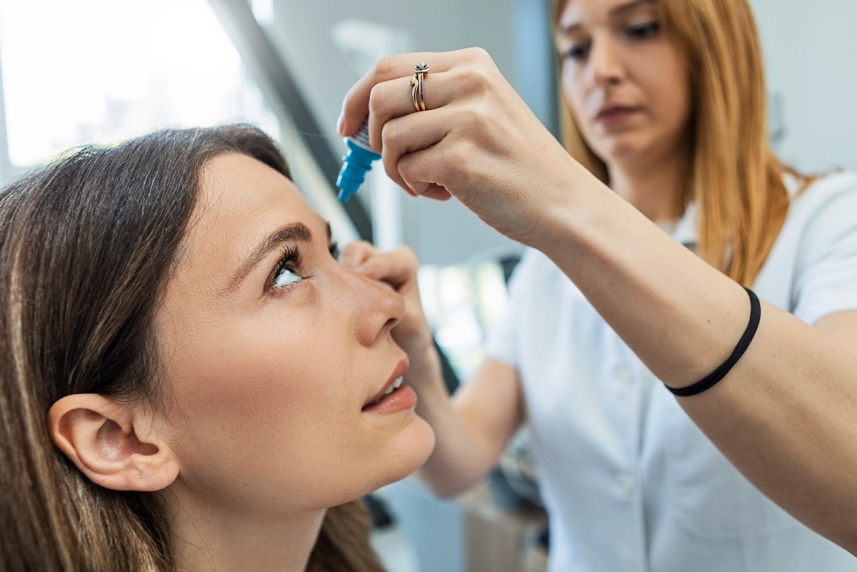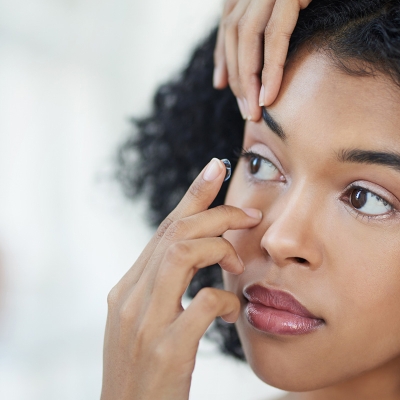What to know before, during and after a dilated eye exam
Understanding what to expect before, during and after a dilated eye exam can help make the experience more comfortable and support long-term eye health at every age.

A dilated eye exam is an important part of protecting vision. It allows an eye care provider to see more of the inside of the eye and check for early signs of disease. A comprehensive eye exam can detect 270 systemic and chronic diseases including diabetes, high blood pressure, autoimmune diseases and cancers.1 The exam uses special eye drops to make the pupils larger, or “dilated.”2 These drops help the provider see the retina, optic nerve and blood vessels at the back of the eye.3
This kind of exam is safe and useful for people of all ages. But it can affect the way the eyes feel for a few hours afterward. Knowing what to expect—and how to prepare—can help make the whole experience easier.
Before the exam
1. Call the eye care provider’s office
Before the visit, it’s a good idea to call the eye care provider’s office to ask if dilation will be part of the exam. A comprehensive eye exam will usually include a dilation, as it is the gold standard for thoroughly examining the eye and should be done every 2 to 3 years. A provider may strongly suggest a dilation based on age, health conditions or family history. For people with diabetes or other risk factors, regular dilated eye exams are often recommended.2
2. Bring sunglasses
Dilated pupils let in more light than usual, so it can be hard to be outside or under bright indoor lights.3 Bringing a pair of sunglasses to the appointment is a smart move. Some clinics may provide disposable shades, but personal sunglasses usually work better and feel more comfortable.
3. Inform others of the exam
Blurry vision might last several hours after the exam.3 Reading, looking at a screen or doing detailed work may be difficult during that time. So it may also be harder to return to work or school right away. It helps to let a boss, coworker or teacher know that the eyes may need a short break after the visit.
Providers in the UnitedHealthcare Vision Network are here to help keep vision healthy. Search now.
4. Organize a ride home
Driving after a dilated exam can also be challenging, especially on sunny days or for those with light sensitivity. Ask a friend, family member or neighbor to come along so they can drive you home. Or schedule a ride with a ride share service.
During the exam
The dilation part of the eye exam is simple. The eye care provider will ask the person to tilt their head back slightly. Then, the provider will gently place a few drops in each eye.
These drops usually take 20 to 30 minutes to work.3 While waiting, the eyes may begin to feel a little different. Some people say they feel more open or sensitive to light. Reading small print may already start to feel blurry before the exam even begins.
Once the pupils are fully dilated, the provider will begin the exam. Using a special light and lens, they will check the back of the eye for signs of problems. This includes early warning signs of serious eye conditions such as:5
Stay on top of eye health with an in-network eye care provider. Search now.
These problems may not cause pain or vision loss at first, so a dilated exam is often the only way to catch them early.5 Early detection can give more options for treatment and can help prevent long-term vision loss.
After the exam
After the exam, the eyes may stay dilated for several hours.4 The exact timing depends on the person, the type of drops used and the amount given.
Remember: During this time, bright light may feel uncomfortable. That’s why it can be helpful to bring sunglasses to the appointment. They can help ease the light sensitivity. This is especially true for people who work outside or plan to be in the sun after the exam. Blurry vision is also common. This may make it hard to read or do tasks that require sharp focus. Some people may feel fine going back to work, while others may need to rest their eyes for a few hours.
It’s helpful to avoid tasks that need strong near vision, like driving, reading small print or using digital screens for long periods. If the eyes feel tired or irritated, resting in a dim room may help.
In some cases, the provider may find something during the exam that needs more attention. If so, they may ask the person to return for a follow-up appointment. This could include more detailed tests, new treatments or a care plan to manage the condition over time.
Dilated eye exams are one of the best ways to take care of long-term eye health. They allow providers to look for eye diseases that may not show symptoms at first. This includes conditions that can lead to vision loss or other serious problems if not treated early.
Sources:
- See the Full Picture of Your Health with an Annual Comprehensive Eye Exam. American Optometric Association
- Is It Necessary to Have My Eyes Dilated During Every Eye Exam? Mayo Clinic, January 25, 2025
- Your Eyes Could Be the Windows to Your Health. American Academy of Ophthalmology, April 21, 2025
- What Are Dilating Eye Drops? American Academy of Ophthalmology, October 15, 2024
- Get a Dilated Eye Exam. National Eye Institute, December 5, 2025


